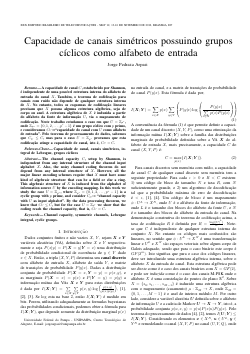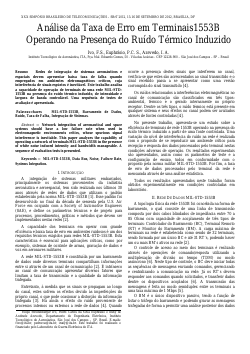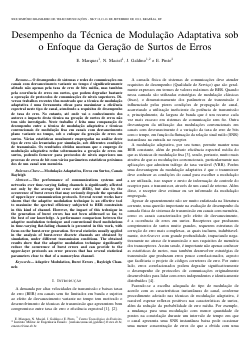
XXX Simpósio Brasileiro de Telecomunicações

Projeto de Detectores via Otimização Convexa para Sensoriamento Espectral em Rádios Cognitivos
Dayan A. Guimarães, Carlos F. A. C. Ribeiro, Rausley A. A. de Souza
DOI: 10.14209/sbrt.2012.13
Keywords: CVX Detectores aleatórios Detectores determinísticos Detector minimax Detectores robustos Otimização convexa Rádio cognitivo Sensoriamento espectral por autovalores
Abstract
Este artigo propõe uma nova abordagem para o projeto de detectores para sensoriamento espectral no contexto de sistemas de rádios cognitivos. Detectores ótimos minimax são projetados através de otimização convexa e aplicados ao teste de razão de verossimilhança generalizado baseado em autovalores. Para este teste é apresentada uma comparação entre os desempenhos de detectores minimax e minimax robustos, determinísticos e aleatórios. Os detectores foram projetados por meio do aplicativo CVX, uma ferramenta baseada em Matlab para especificação e solução de problemas de otimização convexa.Download

Novo Esquema de Escalonamento Cross-layer para Redes Multimídia – DQCA-RP
Josias T. Guimarães, José Marcos C. Brito
DOI: 10.14209/sbrt.2012.15
Keywords: Cross-Layer DQCA Escalonamento Oportunista
Abstract
Um aspecto importante nas redes sem fio multimídia é o escalonamento da transmissão dos pacotes gerados pelos terminais da rede. O DQCA (Distributed Queuing Collision Avoidance) é um protocolo de acesso ao meio de alto desempenho e estável, que mantém uma vazão alta com qualquer carga de tráfego. Entretanto, ele pode permitir índices altos de atraso e variação de atraso. Neste trabalho propõe-se um esquema de escalonamento cross-layer, baseado no DQCA, que visa reduzir o atraso médio, a variação do atraso e as perdas de pacotes de voz, sem queda significativa na vazão de dados. O desempenho do protocolo proposto é comparado, via simulação, com o DQCA e algumas de suas principais variantes.Download

Capacidade de canais simétricos possuindo grupos cíclicos como alfabeto de entrada
Jorge Pedraza Arpasi
DOI: 10.14209/sbrt.2012.16
Keywords: Channel capacity symmetric channels Lebesgue integral cyclic groups
Abstract
The channel capacity independent from any internal structure of the channel input alphabet X. Also, the noisy channel coding theorem do not depend from any internal structure of X. However, all the major linear encoding schemes require that X must have some kind of algebraic structure that can be a field or else a ring. This algebraic structure of X is induced from the alphabet of information source U by the encoding mapping. In this work we study the case U = Zpr , where Zpr = {0,1,2,...,pr − 1} is a cyclic group with p prime, and consider CU := “channel capacity with U as input alphabet”. By the data processing theorem, we know that CU ≤C, but for the case U =Zpr we show that the coding reach the channel capacity, that is, CU = C.Download

Técnica de decodificação híbrida iterativa para códigos LDPC
Walter Prado de Souza Guimarães, Valdemar C. da Rocha Júnior
DOI: 10.14209/sbrt.2012.14
Keywords: LDPC codes BP iterative decoding erasures de- coding hybrid decoding
Abstract
A hybrid decoding system for LDPC codes em- ploying min-sum belief propagation (BP) decoding to correct errors, combined with erasure iterative decoding, is investigated by means of computer simulation. The proposed hybrid decoding system by employing a reduced number of iterations becomes more efficient, especially in the error-floor region, achieving a similar performance with equivalent implementation complexity to that of min-sum BP decoding schemesDownload

Análise da Taxa de Erro em Terminais1553B Operando na Presença do Ruído Térmico Induzido
Ivo, F.S., Euphrásio, P.C. S., Azevedo, I. A.
DOI: 10.14209/sbrt.2012.17
Keywords: MIL-STD-1553B Data Bus Noise Failure Rate Systems Integration
Abstract
Network integration of aeronautical and space systems should have a low failure rate when used in electromagnetic environments critics, whose spurious signal interference is inevitable. This paper analyzes the capability of operating a network of terminals MIL-STD-1553B in the presence of white noise induced intensity and bandwidth manageable. A sequence of evaluation tests is presented.Download

EDFA Gain Variation Problem in Transparent Optical Networks
Victor A. P. Oliveira, and Iguatemi E. Fonseca
DOI: 10.14209/sbrt.2012.18
Keywords: EDFA Gain variation Routing and Wavelength Assignment Algorithm Optical Networks
Abstract
This work presents a study about the impact of Erbium-doped Fiber Amplifier (EDFA) gain variation problem may have on the performance of Dynamic Optical Networks. An analytical model to estimate the EDFA gain variation considering amplifier input power is proposed. Two Impairment Aware RWA algorithms are also proposed. Numerical simulations suggest that network performance can be improved with the elimination of amplifiers gain variations. Results also indicate that proposed analytical model satisfactorily captures the behavior of EDFA’s gain variation.Download

Utilização de Subespaços Livres de Descoerência em Comunicações Quânticas Incondicionalmente Seguras
Elloá B. Guedes, Francisco M. de Assis
DOI: 10.14209/sbrt.2012.19
Keywords: Subespaços Livres de Descoerência; Capaci- dade de Sigilo; Segurança Incondicional
Abstract
Neste trabalho será mostrado como subespaços livres de descoerência em canais quânticos com descoerência coletiva podem ser usados para transmitir informação clássica com sigilo absoluto. Além disso, também será mostrado que, se determinadas condições de simetrias forem garantidas, então a taxa máxima em que estas comunicações sigilosas acontecem iguala-se à capacidade ordinária do canal quântico para o envio de mensagens clássicas. Estes resultados caracterizam uma nova técnica para enviar mensagens clássicas via canais quânticos com segurança incondicional.Download

Modulação para rádio digital utilizando a amplitude de autocorrelação de códigos PN para transporte da informação.
Fabrício de Araújo Carvalho, Fernando Walter
DOI: 10.14209/sbrt.2012.21
Keywords: Digital Radio Broadcasting Spectral Efficiency Pseudo-random codes CDMA PWM.
Abstract
The frequency bands used in mobile communications are allocated according to the type of application. With the need for more channels, the frequency spectrum has become a scarce natural resource. This study shows the results of a proposed modulation using the variation of the autocorrelation of pseudo-random codes to carry information. The work also presents the generation of multiple orthogonal axes to increase the bit rate and in this way improve the Channel efficiency.Download

Video Quality Assessment Based on the Effect of the Estimation of the Spatial Perceptual Information
Carlos D. M. Regis, José V. de M. Cardoso, Marcelo S. Alencar
DOI: 10.14209/sbrt.2012.22
Keywords: Video Quality Assessment Structural Similarity Visual Attention Spatial Perceptual Information Human Visual System.
Abstract
The objective video quality assessment is a quick and low cost alternative compared with the subjective evaluation. However, the objective evaluation is not as reliable, because their results are not always according to the perceived quality of the human visual system. This paper presents a new metric for objective video quality assessment, called PW-SSIM, based on the investigation of how the spatial perceptual information can be used as an estimate to predict the visual attention to a particular region of the video and insert a quality weighting according to the spatial perceptual information values. The PWSSIM presents higher correlation coefficients when compared to popular models (PSNR and SSIM), for a subjective evaluation with 40 participants, considering degraded videos with salt and pepper, blurring and blocking, and 24 participants considering videos subject to Gaussian noise, suggesting that the PW-SSIM has a better ability to predict the perceived video quality for a group of spectators.Download

Desempenho da Técnica de Modulação Adaptativa sob o Enfoque da Geração de Surtos de Erros
E. Marques, N. Maciel, J. Galdino, E. Pinto
DOI: 10.14209/sbrt.2012.23
Keywords: Adaptive Modulation Burst Errors Rayleigh Channels
Abstract
The performance of communications systems and networks over time-varying fading channels is significantly affected not only by the average bit error rate (BER), but also by the occurrence of burst errors that may seriously degrade the operation of upper-layer communication protocols. Several recent works have shown that the adaptive modulation technique is an effective tool to maximize the spectral efficiency subjected to BER constraints in this kind of channel. However, the impact of this technique in the generation of burst errors has not been addressed so far, to the best of our knowledge. A performance comparison between the adaptive modulation technique and conventional fixed modulations in time-varying flat-fading channels is presented in this work, with focus on the burst-error generation. Several statistics usually applied in the analysis of burst-error discrete channels are obtained by simulation, under different transmission conditions. The obtained results show that the adaptive modulation technique significantly reduce the occurrence of burst errors and can provide to the upper-layer protocols an error process that has several statistical parameters close to that of a memoryless channel.Download